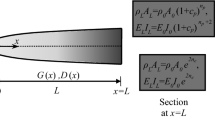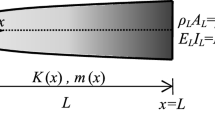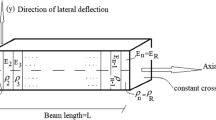Abstract
In this paper, the analytical method and design charts for finding the exact solutions to the free transverse vibration of the exponential axially functionally graded material (AFGM) beams with concentrated tip masses and general boundary conditions are presented. According to the derived formulations, the effects of the elastic supports, attached tip masses, and exponential gradient index on the natural frequencies and mode shapes of the AFGM beams with symmetric and asymmetric boundary conditions are investigated. First, by solving the differential equation governing the free vibration of the exponential AFGM Euler–Bernoulli beams, exact solutions are obtained. The material properties of beams are assumed to vary continuously in the axial direction according to the exponential functions. Second, by applying the general boundary conditions, the matrix of constant factors of the beam is derived explicitly. By setting the determinant of this matrix to zero, the natural frequencies of the exponential AFGM beam with the general boundary conditions will be available. In the following, the mode shapes and design charts of the AFGM beams can be obtained. The advantages of the proposed formulations are accuracy, generality, and simplicity in modeling the various boundary conditions. Results show that tip masses, exponential gradient index, and end supports play an influential role in the dynamic behavior of the AFGM beams. Accordingly, the results and design charts presented for the first time are helpful for the proper design and finding the identical frequency of the exponential AFGM beams, exponential non-uniform beams, and uniform beams with different boundary conditions.











Similar content being viewed by others
References
Ait Atmane, H., Tounsi, A., Meftah, S. A., & Belhadj, H. A. (2011). Free vibration behavior of exponential functionally graded beams with varying cross-section. Journal of Vibration and Control, 17(2), 311–318. https://doi.org/10.1177/1077546310370691
AlSaid-Alwan, H. H. S., & Avcar, M. (2020). Analytical solution of free vibration of FG beam utilizing different types of beam theories: A comparative study. Computers and Concrete, 26(3), 285–292. https://doi.org/10.12989/cac.2020.26.3.285
Anandakumar, G., & Kim, J.-H. (2010). On the modal behavior of a three-dimensional functionally graded cantilever beam: Poisson’s ratio and material sampling effects. Composite Structures, 92(6), 1358–1371. https://doi.org/10.1016/j.compstruct.2009.11.020
Attarnejad, R., Shahba, A., & Eslaminia, M. (2011). Dynamic basic displacement functions for free vibration analysis of tapered beams. Journal of Vibration and Control, 17(14), 2222–2238. https://doi.org/10.1177/1077546310396430
Avcar, M. (2019). Free vibration of imperfect sigmoid and power law functionally graded beams. Steel and Composite Structures, 30(6), 603–615. https://doi.org/10.12989/scs.2019.30.6.603
Avcar, M., Hadji, L., & Civalek, Ö. (2021). Natural frequency analysis of sigmoid functionally graded sandwich beams in the framework of high order shear deformation theory. Composite Structures, 276, 114564. https://doi.org/10.1016/j.compstruct.2021.114564
Bambaeechee, M. (2019). Free vibration of AFG beams with elastic end restraints. Steel and Composite Structures, 33(3), 403–432. https://doi.org/10.12989/scs.2019.33.3.403
Bambaeechee, M. (2022). Free transverse vibration of general power-law NAFG beams with tip masses. Journal of Vibration Engineering & Technologies. https://doi.org/10.1007/s42417-022-00519-7
Çallıoğlu, H., Demir, E., Yılmaz, Y., & Sayer, M. (2013). Vibration analysis of functionally graded sandwich beam with variable cross-section. Mathematical and Computational Applications, 18(3), 351–360. https://doi.org/10.3390/mca18030351
Celebi, K., & Tutuncu, N. (2014). Free vibration analysis of functionally graded beams using an exact plane elasticity approach. Proceedings of the Institution of Mechanical Engineers, Part c: Journal of Mechanical Engineering Science, 228(14), 2488–2494. https://doi.org/10.1177/0954406213519974
Chen, W.-R., & Chang, H. (2021). Vibration analysis of bidirectional functionally graded Timoshenko beams using Chebyshev collocation method. International Journal of Structural Stability and Dynamics, 21(01), 2150009. https://doi.org/10.1142/S0219455421500097
Duy, H. T., Van, T. N., & Noh, H. C. (2014). Eigen analysis of functionally graded beams with variable cross-section resting on elastic supports and elastic foundation. Structural Engineering and Mechanics, 52(5), 1033–1049. https://doi.org/10.12989/sem.2014.52.5.1033
Ebrahimi, F., & Mokhtari, M. (2015). Vibration analysis of spinning exponentially functionally graded Timoshenko beams based on differential transform method. Proceedings of the Institution of Mechanical Engineers, Part g: Journal of Aerospace Engineering, 229(14), 2559–2571. https://doi.org/10.1177/0954410015580801
Erdurcan, E. F., & Cunedioğlu, Y. (2020). Free vibration analysis of a functionally graded material coated aluminum beam. AIAA Journal, 58(2), 949–954. https://doi.org/10.2514/1.J059002
He, M.-F., Huang, Y., & Rong, H.-W. (2017). An efficient approach for the calculation of eigenfrequencies and mode shapes of tapered and axially functionally graded Rayleigh beams. Acta Acustica United with Acustica, 103(2), 276–287. https://doi.org/10.3813/AAA.919056
Hosseini Hashemi, S., Bakhshi Khaniki, H., & Bakhshi Khaniki, H. (2016). Free vibration analysis of functionally graded materials non-uniform beams. International Journal of Engineering - Transactions c: Aspects, 29(12), 1734–1740. https://doi.org/10.5829/idosi.ije.2016.29.12c.12
Huang, Y., & Li, X.-F. (2010). A new approach for free vibration of axially functionally graded beams with non-uniform cross-section. Journal of Sound and Vibration, 329(11), 2291–2303. https://doi.org/10.1016/j.jsv.2009.12.029
Karamanlı, A. (2018). Free vibration analysis of two directional functionally graded beams using a third order shear deformation theory. Composite Structures, 189, 127–136. https://doi.org/10.1016/j.compstruct.2018.01.060
Keshmiri, A., Wu, N., & Wang, Q. (2018). Vibration analysis of non-uniform tapered beams with nonlinear FGM properties. Journal of Mechanical Science and Technology, 32(11), 5325–5337. https://doi.org/10.1007/s12206-018-1031-x
Kumar, S. (2020). Dynamic behaviour of axially functionally graded beam resting on variable elastic foundation. Archive of Mechanical Engineering, 67(4), 451–470. https://doi.org/10.24425/ame.2020.131700
Kumar, S., Mitra, A., & Roy, H. (2015). Geometrically nonlinear free vibration analysis of axially functionally graded taper beams. Engineering Science and Technology, an International Journal, 18(4), 579–593. https://doi.org/10.1016/j.jestch.2015.04.003
Lai, H.-Y., Hsu, J.-C., & Chen, C.-K. (2008). An innovative eigenvalue problem solver for free vibration of Euler-Bernoulli beam by using the Adomian decomposition method. Computers & Mathematics with Applications, 56(12), 3204–3220. https://doi.org/10.1016/j.camwa.2008.07.029
Li, X.-F., Kang, Y.-A., & Wu, J.-X. (2013). Exact frequency equations of free vibration of exponentially functionally graded beams. Applied Acoustics, 74(3), 413–420. https://doi.org/10.1016/j.apacoust.2012.08.003
Liu, P., Lin, K., Liu, H., & Qin, R. (2016). Free transverse vibration analysis of axially functionally graded tapered Euler-Bernoulli beams through spline finite point method. Shock and Vibration, 2016, 5891030-1–5891123. https://doi.org/10.1155/2016/5891030
Liu, Y., & Shu, D. W. (2014). Free vibration analysis of exponential functionally graded beams with a single delamination. Composites Part b: Engineering, 59, 166–172. https://doi.org/10.1016/j.compositesb.2013.10.026
Lohar, H., Mitra, A., & Sahoo, S. (2016). Natural frequency and mode shapes of exponential tapered AFG beams on elastic foundation. International Frontier Science Letters, 9, 9–25. https://doi.org/10.18052/www.scipress.com/IFSL.9.9
Mahmoud, M. A. (2019). Natural frequency of axially functionally graded, tapered cantilever beams with tip masses. Engineering Structures, 187, 34–42. https://doi.org/10.1016/j.engstruct.2019.02.043
Rajasekaran, S. (2013). Buckling and vibration of axially functionally graded nonuniform beams using differential transformation based dynamic stiffness approach. Meccanica, 48(5), 1053–1070. https://doi.org/10.1007/s11012-012-9651-1
Rao, S. S. (2019). Vibration of Continuous Systems (2nd Edition). New York: John Wiley & Sons Inc. https://doi.org/10.1002/9781119424284
Rezaiee-Pajand, M., & Hozhabrossadati, S. M. (2016a). Analytical and numerical method for free vibration of double-axially functionally graded beams. Composite Structures, 152, 488–498. https://doi.org/10.1016/j.compstruct.2016.05.003
Rezaiee-Pajand, M., & Hozhabrossadati, S. M. (2016b). Free vibration analysis of a double-beam system joined by a mass-spring device. Journal of Vibration and Control, 22(13), 3004–3017. https://doi.org/10.1177/1077546314557853
Rezaiee-Pajand, M., & Masoodi, A. R. (2018). Exact natural frequencies and buckling load of functionally graded material tapered beam-columns considering semi-rigid connections. Journal of Vibration and Control, 24(9), 1787–1808. https://doi.org/10.1177/1077546316668932
Rezaiee-Pajand, M., Shahabian, F., & Bambaeechee, M. (2015). Buckling analysis of semi-rigid gabled frames. Structural Engineering and Mechanics, 55(3), 605–638. https://doi.org/10.12989/sem.2015.55.3.605
Šalinić, S., Obradović, A., & Tomović, A. (2018). Free vibration analysis of axially functionally graded tapered, stepped, and continuously segmented rods and beams. Composites Part b: Engineering, 150, 135–143. https://doi.org/10.1016/j.compositesb.2018.05.060
Sari, M. S., & Al-Dahidi, S. (2020). Vibration characteristics of multiple functionally graded nonuniform beams. Journal of Vibration and Control. https://doi.org/10.1177/1077546320956768
Selmi, A., & Mustafa, A. A. (2021). Dynamic analysis of bi-dimensional functionally graded beams. Materials Today: Proceedings. https://doi.org/10.1016/j.matpr.2021.03.726
Selmi, A. (2021). Vibration behavior of bi-dimensional functionally graded beams. Structural Engineering and Mechanics, 77(5), 587–599. https://doi.org/10.12989/sem.2021.77.5.587
Shvartsman, B. S., & Majak, J. (2016). Free vibration analysis of axially functionally graded beams using method of initial parameters in differential form. Advances in Theoretical and Applied Mechanics, 9, 31–42. https://doi.org/10.12988/atam.2016.635
Şimşek, M. (2015). Bi-directional functionally graded materials (BDFGMs) for free and forced vibration of Timoshenko beams with various boundary conditions. Composite Structures, 133, 968–978. https://doi.org/10.1016/j.compstruct.2015.08.021
Soltani, M., & Asgarian, B. (2019). New hybrid approach for free vibration and stability analyses of axially functionally graded Euler-Bernoulli beams with variable cross-section resting on uniform Winkler-Pasternak foundation. Latin American Journal of Solids and Structures, 16(3), 173-1–173-25. https://doi.org/10.1590/1679-78254665
Tang, A.-Y., Wu, J.-X., Li, X.-F., & Lee, K. Y. (2014). Exact frequency equations of free vibration of exponentially non-uniform functionally graded Timoshenko beams. International Journal of Mechanical Sciences, 89(Supplement C), 1–11. https://doi.org/10.1016/j.ijmecsci.2014.08.017
Tossapanon, P., & Wattanasakulpong, N. (2020). Flexural vibration analysis of functionally graded sandwich plates resting on elastic foundation with arbitrary boundary conditions: Chebyshev collocation technique. Journal of Sandwich Structures & Materials, 22(2), 156–189. https://doi.org/10.1177/1099636217736003
Wang, C. Y., & Wang, C. M. (2012). Exact vibration solution for exponentially tapered cantilever with tip mass. Journal of Vibration and Acoustics, 134(4), 041012-1–041012-4. https://doi.org/10.1115/1.4005835
Wang, C. Y., & Wang, C. M. (2013). Structural Vibration: Exact Solutions for Strings, Membranes, Beams, and Plates (1 edition). Boca Raton, Florida: CRC Press. https://doi.org/10.1201/b15348
Wang, Z., Wang, X., Xu, G., Cheng, S., & Zeng, T. (2016). Free vibration of two-directional functionally graded beams. Composite Structures, 135, 191–198. https://doi.org/10.1016/j.compstruct.2015.09.013
Wattanasakulpong, N., & Bui, T. Q. (2018). Vibration analysis of third-order shear deformable FGM beams with elastic support by Chebyshev collocation method. International Journal of Structural Stability and Dynamics, 18(05), 1850071. https://doi.org/10.1142/S0219455418500712
Wattanasakulpong, N., Chaikittiratana, A., & Pornpeerakeat, S. (2018). Chebyshev collocation approach for vibration analysis of functionally graded porous beams based on third-order shear deformation theory. Acta Mechanica Sinica, 34(6), 1124–1135. https://doi.org/10.1007/s10409-018-0770-3
Wattanasakulpong, N., & Mao, Q. (2017). Stability and vibration analyses of carbon nanotube-reinforced composite beams with elastic boundary conditions: Chebyshev collocation method. Mechanics of Advanced Materials and Structures, 24(3), 260–270. https://doi.org/10.1080/15376494.2016.1142020
Yuan, J., Pao, Y.-H., & Chen, W. (2016). Exact solutions for free vibrations of axially inhomogeneous Timoshenko beams with variable cross section. Acta Mechanica, 227(9), 2625–2643. https://doi.org/10.1007/s00707-016-1658-6
Zhao, Y., Qin, B., Wang, Q., & Liang, X. (2022). A unified Jacobi-Ritz approach for vibration analysis of functionally graded porous rectangular plate with arbitrary boundary conditions based on a higher-order shear deformation theory. Thin-Walled Structures, 173, 108930. https://doi.org/10.1016/j.tws.2022.108930
Funding
The authors received no financial support for the research, authorship, and/or publication of this article.
Author information
Authors and Affiliations
Contributions
Bambaeechee Mohsen: Conceptualization, Methodology, Software, Formal analysis, Investigation, Writing- Original draft preparation, Writing- Reviewing and Editing, Visualization Supervision. Qazizadeh Morteza Jalili: Investigation, Resources, Writing- Reviewing and Editing. Movahedian Omid: Software, Formal analysis, Validation, Investigation, Reviewing.
Corresponding author
Ethics declarations
Competing interests
The authors declare no competing interests.
Conflict of interests
The authors declared no potential conflicts of interest with respect to the research, authorship, and/or publication of this article.
Additional information
Publisher's Note
Springer Nature remains neutral with regard to jurisdictional claims in published maps and institutional affiliations.
Appendix
Appendix
The elements of the constant coefficients matrix, A for the exponential AFGM beam with carrying tip masses and various elastic boundary conditions in the framework of the Euler–Bernoulli theory are as follows:
Rights and permissions
Springer Nature or its licensor (e.g. a society or other partner) holds exclusive rights to this article under a publishing agreement with the author(s) or other rightsholder(s); author self-archiving of the accepted manuscript version of this article is solely governed by the terms of such publishing agreement and applicable law.
About this article
Cite this article
Bambaeechee, M., Jalili Qazizadeh, M. & Movahedian, O. Free vibration analysis of exponential AFGM beams with general boundary conditions and tip masses. Asian J Civ Eng 24, 539–557 (2023). https://doi.org/10.1007/s42107-022-00517-w
Received:
Accepted:
Published:
Issue Date:
DOI: https://doi.org/10.1007/s42107-022-00517-w




